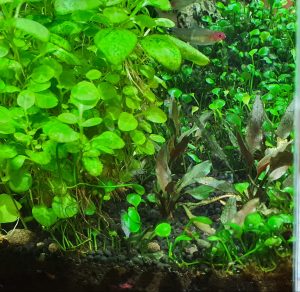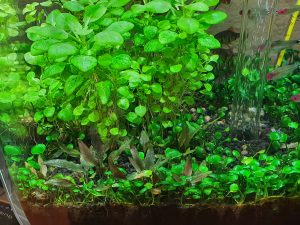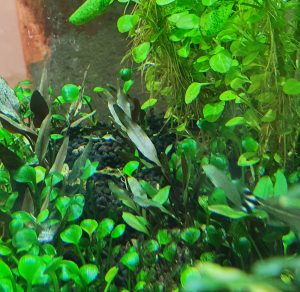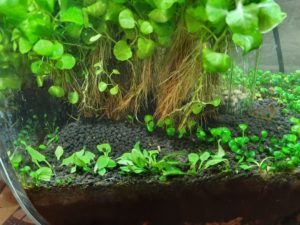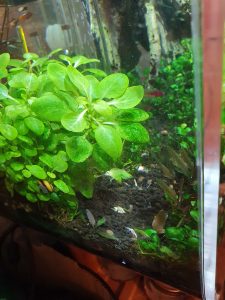
Jurijs Jutjajevs’ (of Tropica) has a “pro tip” for avoiding ‘crypt melt’ and getting Cryptocoryne species more rapidly adapted to submerged growth in an aquarium: cut off all the emersed form leaves when planting. It’s quite a dramatic thing to get your new plants in from the vendor and then immediately cut all the leaves off, but I gave that a try with Cryptocoryne lutea ‘Hobbit’ and it’s time to report the results.
In the ‘before’ picture you can see the stumps of the newly planted row of ‘Hobbits’ to the immediate right of the Lobelia cardinalis ‘Dwarf’ and to the left of a mature row of fully adapted submerged form Hobbits up against the glass. The idea is for the new plants to focus energy on developing submerged form leaves straight away since there are no residual emersed form leaves left. Another upside is not having to clean up the decayed form of the emersed leaves as the plant transitions.
Cutting off Cryptocoryne ermersed form leaves really works!
Pre-trimmed Cryptocoryne lutea ‘Hobbit’ six weeks after planting
Jurijs’ tip worked beautifully! The newly planted row of Hobbits have in just six weeks grown fully adapted submerged form leaves and are already more than half the size of the Hobbits planted six months ago that had the emersed form leaves left on. The new Hobbits have adapted so well and so quickly that it’s hard to visually pick them out behind the row of older Hobbits.
Non-pre-trimmed Cryptocoryne lutea ‘Hobbit’ six weeks after planting
When the emersed form leaves are left on at planting, there are at six weeks a few fully submerged form leaves present, but most of the plant is still trying to give it a go with emersed form leaves. That might be a good strategy in the wild where water levels might fluctuate above and below the plant, but it won’t work long-term at the bottom of an aquarium.
Great tip for all Cryptocoryne species (except Cryptocoryne parva)
Jurijs says the tip works for all species of crypts except for Cryptocoryne parva. Parva doesn’t change its leaf form between emersed and submerged growth, so there’s no need to ‘help’ it transition.
Special note: also don’t try this with Cryptocoryne species grown in tissue culture form.
